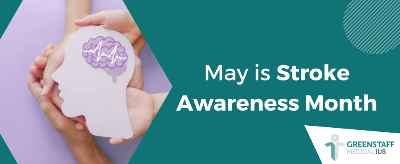
May is Stroke Awareness Month and is the leading cause of adult disability in the United States. A stroke, sometimes call a brain attack, happens in one of two ways: A blocked artery or a ruptured artery. Stroke kills nearly 150,000 of the 860,000 Americans who die of cardiovascular disease each year and is occurring more often in younger people.
A stroke can happen to anyone, at any time, including children. According to Centers for Disease Control and Prevention, every year about 800,000 people in the United States have a stroke—and about 1 out of 4 of those strokes are recurrent strokes. Once you have one stroke, you are at greater risk of having another one. Factors such as your age, sex, and ethnicity can increase your risk of having a stroke. There are however many unhealthy habits, such as smoking, drinking too much alcohol, and not getting enough exercise, that you can change to lower your stroke risk. Having other medical issues like high blood pressure, high cholesterol, diabetes, or obesity can also increase your risk for stroke. By treating these conditions, you can reduce your risk immensely.
High blood pressure is the leading cause of stroke, known as the “silent killer”.
Nearly half of American adults have high blood pressure, many of which don’t even know they have it. This Stoke Awareness Month encourages people to have their blood pressure checked and highlights the importance of maintaining a healthy lifestyle to reduce the risk of a stroke.
Learning the warning signs might just save a life from stroke. In the event of a suspected stroke, you need to act fast.
Face dropping: Does one side of the face droop or is it numb? Ask the person to smile. Is the person's smile uneven?
Arm Weakness: Is one arm weak or numb? Ask the person to raise both arms. Does one arm drift downward?
Speech: Is speech slurred? Is the person unable to speak or hard to understand? Ask the person to repeat a simple sentence, like "The sky is blue."
Time to call 911: If someone shows any of these symptoms, even if the symptoms go away, call 9-1-1 and get to a hospital immediately. Check the time so you'll know when the first symptoms appeared.
It is important for adults to get 7-9 hours of sleep per night, and even more for teenagers and young children. Having control of your health and wellbeing means having regular check-ups with your health care provider to talk about managing your risk factors. A healthy diet and regular exercise are always important, along with reducing your intake of alcohol, sodium, sugar, and fats. Deciding to quit smoking is one of the top treatments, although easier said than done. Make your health a priority and avoid any risk, especially if a stroke runs in your family.
When it comes to stroke, every second counts! Nearly 2 million brain cells die each minute a stroke remains untreated. If a person infected seeks immediate treatment, the effects can often be reversed or drastically reduced. But if they're unsure or they wait to see if symptoms will go away, the window of opportunity for effective treatment can close. Talk about your health conditions, and help raise awareness about the signs, symptoms, and preventions of a stroke to help reduce risk. It can happen to anyone.
Sources:
https://www.webmd.com/stroke/news/20160513/5-warning-signs-of-stroke
https://www.cdc.gov/stroke/docs/Know_the_Facts_About_Stroke.pdf
https://newsroom.heart.org/events/may-is-american-stroke-month-and-hypertension-awareness-and-more